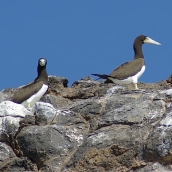Brown Booby (Sula leucogaster)
Seabird from 65-75 cm in length, wingspan from 135-150 cm. The back, head, neck and tips of the underwing of the adult are chocolate-brown, which contrasts with a completely white belly, and it has interdigital membranes on the legs. The bill is robust and straight, which is characteristic of other members of the family Sulidae. In Macaronesia, this pantropical species only breeds in the Cape Verde Islands, specifically on Raso, Boavista, Santiago, Brava and the islets of Rombos; it is occasionally present in the Azores, Madeira and the Canarias, and along the Atlantic coast of Morocco. The brown booby feeds on fish and other marine life by plunge-diving or snatching from the surface. It gathers in numerous (100-300 pairs) breeding colonies on coastal cliffs, islets and rocky outcrops. It breeds throughout the year, laying a clutch of 1-3 eggs in a very basic, make-shift nest of small stones, twigs or grasses and the odd feather. Declining numbers were noticed in the latter half of the 20th century and the current population stands at around 1,000 pairs throughout Cape Verde. Threats to this species include uncontrolled human visits to the colonies, egg and chick collection, and the introduction of non-native species, such as cats and dogs, into the islets and rocky crags where the brown booby breeds. An important conservation measure was the declaration of certain islets (e.g., Raso and Rombos) as protected natural areas, but permanent surveillance and visitor monitoring are required.













